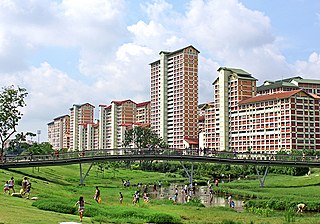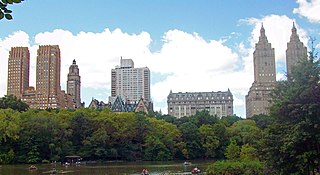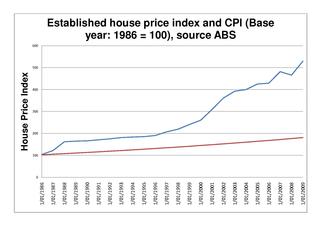Related Research Articles

A suburb is an area within a metropolitan area which has a higher or lower population density and sometimes less detached housing. In many metropolitan areas suburbs rise in population during the day and are where most jobs are located; being major commercial and job hubs, many suburbs also exist as separate residential communities within commuting distance of a larger city. Suburbs can have their own political or legal jurisdiction, especially in the United States, but this is not always the case, especially in the United Kingdom, where most suburbs are located within the administrative boundaries of cities. In most English-speaking countries, suburban areas are defined in contrast to central city or inner city areas, but in Australian English and South African English, suburb has become largely synonymous with what is called a "neighborhood" in the U.S., but it is used in contrast with inner city areas.

Public housing is a form of housing tenure in which the property is usually owned by a government authority, either central or local. Although the common goal of public housing is to provide affordable housing, the details, terminology, definitions of poverty, and other criteria for allocation vary within different contexts. Within the OECD, social housing represents an average of 7% of national housing stock (2020), ranging from ~34% in the Netherlands to less than 1% in Colombia.

A housing cooperative, or housing co-op, is a legal entity, usually a cooperative or a corporation, which owns real estate, consisting of one or more residential buildings; it is one type of housing tenure. Typically housing cooperatives are owned by shareholders but in some cases they can be owned by a non-profit organization. They are a distinctive form of home ownership that have many characteristics that differ from other residential arrangements such as single family home ownership, condominiums and renting.

Urban sprawl is defined as "the spreading of urban developments on undeveloped land near a more or less densely populated city". Urban sprawl has been described as the unrestricted growth in many urban areas of housing, commercial development, and roads over large expanses of land, with little concern for very dense urban planning. Sometimes the urban areas described as the most "sprawling" are the most densely populated. In addition to describing a special form of urbanization, the term also relates to the social and environmental consequences associated with this development. In modern times some suburban areas described as "sprawl" have less detached housing and higher density than the nearby core city. Medieval suburbs suffered from the loss of protection of city walls, before the advent of industrial warfare. Modern disadvantages and costs include increased travel time, transport costs, pollution, and destruction of the countryside. The revenue for building and maintaining urban infrastructure in these areas are gained mostly through property and sales taxes. As most jobs in the US are now located in suburbs generating much of the revenue, although a lack of growth will require higher tax rates.

Real estate economics is the application of economic techniques to real estate markets. It tries to describe, explain, and predict patterns of prices, supply, and demand. The closely related field of housing economics is narrower in scope, concentrating on residential real estate markets, while the research on real estate trends focuses on the business and structural changes affecting the industry. Both draw on partial equilibrium analysis, urban economics, spatial economics, basic and extensive research, surveys, and finance.

Stan Grant is an Australian journalist, writer and radio and television presenter, since the 1990s. He has written and spoken on Indigenous issues and his Aboriginal identity. He is a Wiradjuri man.

Suburbanization (AE), or suburbanisation (BE), is a population shift from historic core cities or rural areas into suburbs, resulting in the formation of (sub)urban sprawl. As a consequence of the movement of households and businesses away from city centers, low-density, peripheral urban areas grow.
Poverty in Australia deals with the incidence of relative poverty in Australia and its measurement. Relative income poverty is measured as a percentage of the population that earns less in comparison to the median wage of the working population.

Affordable housing is housing which is deemed affordable to those with a household income at or below the median as rated by the national government or a local government by a recognized housing affordability index. Most of the literature on affordable housing refers to mortgages and a number of forms that exist along a continuum – from emergency homeless shelters, to transitional housing, to non-market rental, to formal and informal rental, indigenous housing, and ending with affordable home ownership.

The economy of Sydney is notable for its importance in the areas of trading, manufacturing, finance, education, and distribution in Australia. Sydney has the largest economy in Australia.

Medium-density housing is a term used within urban planning and academic literature to refer to a category of residential development that falls between detached suburban housing and large multi-story buildings. There is no singular definition of medium-density housing as its precise definition tends to vary between jurisdiction. Scholars however, have found that medium density housing ranges from about 25 to 80 dwellings per hectare, although most commonly sits around 30 and 40 dwellings/hectare. Typical examples of medium-density housing include duplexes, triplexes, townhouses, row homes, detached homes with garden suites, and walk-up apartment buildings.

Public housing in Australia is one part of social housing and the other is community housing. Public housing is provided by departments of state governments. Australian public housing operates within the framework of the Commonwealth-State Housing Agreement, by which funding for public and community housing is provided by both federal and state governments. According to the 2006 census, Australia's public housing stock consisted of some 304,000 dwellings out of a total housing stock of more than 7.1 million dwellings, or 4.2% of all housing stock.

Home ownership in Australia is considered a key cultural icon, and part of the Australian tradition known as the Great Australian Dream of "owning a detached house on a fenced block of land." Home ownership has been seen as creating a responsible citizenry; according to a former Premier of Victoria: "The home owner feels that he has a stake in the country, and that he has something worth working for, living for, fighting for."

The Australian property market comprises the trade of land and its permanent fixtures located within Australia. The average Australian property price grew 0.5% per year from 1890 to 1990 after inflation, however rose from 1990 to 2017 at a faster rate. House prices in Australia receive considerable attention from the media and the Reserve Bank and some commentators have argued that there is an Australian property bubble.

The Australian property bubble is the economic theory that the Australian property market has become or is becoming significantly overpriced and due for a significant downturn. Since the early 2010s, various commentators, including one Treasury official, have claimed the Australian property market is in a significant bubble.

Housing in the state of Victoria, Australia is characterised by high rates of private housing ownership, minimal and lack of public housing and high demand for, and largely unaffordable, rental housing. Outside of Melbourne, home to 70% of the state's population, housing and rent is more affordable. In Melbourne, access to public housing is generally better, but housing and rent are less affordable.

Housing inequality is a disparity in the quality of housing in a society which is a form of economic inequality. The right to housing is recognized by many national constitutions, and the lack of adequate housing can have adverse consequences for an individual or a family. The term may apply regionally, temporally or culturally. Housing inequality is directly related to racial, social, income and wealth inequality. It is often the result of market forces, discrimination and segregation.
The property bubble in New Zealand is a major national economic and social issue. Since the early 1990s, house prices in New Zealand have risen considerably faster than incomes, putting increasing pressure on public housing providers as fewer households have access to housing on the private market. The property bubble has produced significant impacts on inequality in New Zealand, which now has one of the highest homelessness rate in the OECD and a record-high waiting list for public housing. Government policies have attempted to address the crisis since 2013, but have produced limited impacts to reduce prices or increase the supply of affordable housing. However, prices started falling in 2022 in response to tightening of mortgage availability and supply increasing. Some areas saw drops as high as around 9% - albeit from very high prices.

Affordable housing is housing that is deemed affordable to those with a median household income as rated by the national government or a local government by a recognized housing affordability index. A general rule is no more than 30% of gross monthly income should be spent on housing, to be considered affordable as the challenges of promoting affordable housing varies by location.
Judith Nancy Yates was an Australian housing economist. She was a lecturer and associate professor at the University of Sydney from 1971 to 2009. As a social liberal economist, she published over 120 papers in academic journals and government and industry reports on most aspects of Australia's housing sector, most notably on distributional aspects of the tax and finance system, on affordability and the supply of low-rent housing.Throughout her career she was appointed to a number of government advisory committees, and she contributed to many government inquiries.
References
- ↑ "Get rich or die trying". this. 3 August 2015. Retrieved 17 February 2020.
- ↑ " "The Adelaide Review [Issues] Sprawl consumes all". Archived from the original on 23 August 2006. Retrieved 5 September 2006." Sprawl Consumes All. adelaide.com.au 29 October 2004. URL accessed 5 September 2006.
- ↑ "Archived copy" (PDF). Archived from the original (PDF) on 4 March 2016. Retrieved 5 August 2015.
{{cite web}}: CS1 maint: archived copy as title (link) - ↑ "consilidation". www.sage.unsw.edu.au. Archived from the original on 4 March 2016. Retrieved 5 August 2015.
- ↑ "Data" (PDF). www.be.unsw.edu.au.
- ↑ "Sydney: From World City to "Sick Man" of Australia - Newgeography.com". www.newgeography.com.
- ↑ Davey, Melissa (24 January 2016). "Stan Grant's speech on racism and the Australian dream goes viral". The Guardian. Retrieved 16 February 2020.
- ↑ "Stan Grant: Racism and the Australian dream". The Ethics Centre. 24 January 2016. Retrieved 16 February 2020.
- ↑ "The Australian Dream: Blood, History And Becoming". Quarterly Essay. 8 November 2016. Retrieved 17 February 2020.
- ↑ Enker, Debi (13 May 2020). "Miriam Margolyes holds up a critical mirror to Australia in new doco Almost Australian". The Sydney Morning Herald. Retrieved 26 May 2020.
- ↑ End of the Great Australian Dream? (from age.com.au, 14 July 2003. Accessed 5 September 2006)
- ↑ Long, Stephen (31 October 2021). "From a 'class divide' to 'intergenerational theft', Australia's real estate frenzy leaves many behind". ABC News. Australian Broadcasting Corporation. Retrieved 1 November 2021.
- ↑ 2008 Senate Select Committee – ‘A good house is hard to find’ – Housing Affordability in Australia Archived 19 July 2010 at the Wayback Machine
- ↑ "Realestate Investing Australia Making Easy Money". A P I. Retrieved 19 April 2017.
- ↑ "That great Australian dream". www.nga.gov.au.